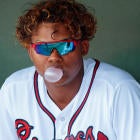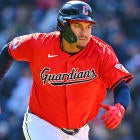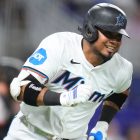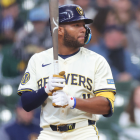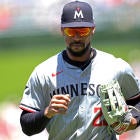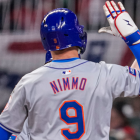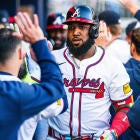With the regular season concluding, we've decided to take a look at each team's future -- not by using a crystal ball or other psychic abilities, but by evaluating their farm systems. Below you'll find our ranking of the top five prospects in the organization -- sorted by perceived future potential -- as well as five other players who fit various categories. Those categories are:
2020 contributor: A player who is likely to play a role for the big-league team next season.
Analyst's pick: A player who is a strong statistical performer and/or whose underlying measures are better than the scouting reports suggest.
Riser: A player on the way up.
Faller: A player on the way down.
One to watch: An interesting player to keep in mind (for whatever reason).
These rankings were compiled after talking with various industry sources about the systems (and players) in question. It should be acknowledged that this process is more art than science, and that there are limits to ordinal rankings. Still, it's an intuitive system, and our hope is that the write-ups will answer any questions by providing additional context and analysis of each player -- such as their pluses and minuses; the risk factors involved; and their estimated arrival date.
One last word on eligibility: we're following MLB's rookie guidelines by disqualifying any player with more than 130 big-league at-bats or 50 innings pitched.
The Braves system has graduated a ton of talent in recent years. There are still more quality players on the way, too.
1. Cristian Pache, OF
At his best, Cristian Pache looks like a future star: a demon center fielder with more power potential than his 21 career home runs suggest. At his less-than-best, he still looks like a valuable player -- just one who may not add as much as hoped offensively.
Pache was having a breakout season before a late promotion to Triple-A, where some of his gains -- at least so far as lifting the ball and hitting for more power -- disappeared. He continued to walk more than usual, which is a welcomed sign for someone known as a free-swinger, but he remained as pull-heavy as ever.
Indeed, Pache pulled around 57 percent of his batted balls in 2019, according to FanGraphs. Only three qualified big-league hitters finished over 50 percent, and none higher than Max Kepler at 53.4 percent. Whatever works, but that kind of dependency on pulling the baseball could speak to a deficiency within his game.
Despite Pache's well-above-average speed, he hasn't yet morphed into a stolen-base threat -- not a good one, anyway. An 8-for-19 season (you read that correctly) leaves him with a 60 percent career success rate. That just isn't going to fly in the majors.
This isn't meant to be dismissive of Pache's ability to grow, either. He won't turn 21 until Nov. 19, and it's possible he taps into some of that power and learns the nuances of basestealing. It's just a reminder that even very good prospects like Pache -- who should develop into an above-average regular -- sometimes have flaws that need to be noted.
2. Kyle Wright, RHP
The Braves picked Kyle Wright fifth overall in 2017 out of Vanderbilt based in part because he seemed like a quick riser. He had the delivery, the athleticism, the body, the arsenal, the track record against tough competition, and so on. Two full seasons later, Wright is still trying to gain traction in the majors. In 11 appearances, he's yielded six home runs and nearly as many walks (19) as strikeouts (23). As the children might say, major yikes.
To Wright's credit, he pitched well in Triple-A and seemed unbothered by the altered ball. Besides, his big-league exposure is a small sample -- albeit an unkind small sample.
Given all the perceived pros in Wright's game, he still has a chance to develop into a mid-rotation starter or a tick better. If he continues to struggle for much longer, however, don't be surprised if he starts slipping down these lists and the depth chart.
3. Ian Anderson, RHP
The third pick in the 2016 draft, Ian Anderson should make his big-league debut in 2020.
Anderson has the makings of a mid-rotation starter or better. He has the size, the delivery, the arsenal -- all three pitches have above-average potential. What he doesn't have is the command. Anderson has walked four batters per nine throughout his minor-league career, including 4.3 per nine in 2019. Put another way, his 11.3 percent walk rate would have tied Dakota Hudson for the highest among in the majors among qualified starters.
Obviously Anderson has more bat-missing ability than Hudson, perhaps making his situation more comparable to the Robbie Rays and Luis Castillos of the league. But it's asking a lot from any pitcher to require a top-15 strikeout rate to overcome their wildness.
Anderson won't turn 22 until May, so he has time to improve his command. Perhaps he'll be the next to pull a Michael Kopech?
4. Drew Waters, OF
The Braves' other top outfield prospect, Drew Waters split the year between Double- and Triple-A, hitting .309/.360/.459 with 56 extra-base hits and 16 steals. He did most of his damage before his promotion, as he hit just .271/.336/.374 in 26 games in Gwinnett.
Waters is a quality athlete who would be viewed as Atlanta's center fielder of the future were it not for Pache. He has the arm to play right if need be. At the plate, he's a nominal switch-hitter who struggles against left-handed pitching. That's okay, given most pitchers throw right-handed.
Waters doesn't walk quite as much as one would like, and ideally he would tap into his raw power more often. Provided he can keep his strikeouts in check, then he has a chance to become an intriguing two-way contributor -- perhaps as soon as during the 2020 season.
5. Bryse Wilson, RHP
Bryse Wilson tends to get overlooked in the Braves system due to the presence of other, higher-profile arms. Even so, he's already made nine big-league appearances over the past two seasons, and is likely to add to that total early and often in 2020.
Wilson has a quality mid-90s fastball, but there are some questions about his future role due to other aspects of his game. His secondaries are inconsistent in nature, and so is his command -- his delivery includes a wrist wrap, a high elbow, and crossfire action. He also pitches from a low three-quarters slot, which could make him susceptible to lefties.
Wilson won't turn 22 until December, so there's no sense pretending he's a finished product. His range of outcomes stretches from mid-rotation starter to reliever.
2020 contributor: Patrick Weigel, RHP
Patrick Weigel is a large lad who missed most of the 2018 season after undergoing Tommy John surgery. He has a big-time fastball and solid secondaries, but struggled with his command -- perhaps not a surprise, given his delivery. Weigel will likely land in the bullpen, where he could contribute at the big-league level as soon as the 2020 season.
Analyst's pick: Justin Dean, OF
Atlanta's 17th-round pick in 2018, Justin Dean can really run -- hence 47 steals on 57 tries in 2019. Dean, who is listed at 5-foot-6 has shown some bat-to-ball skills as well as a willingness to walk. He's probably not going to provide much (if any) power, though, and he'll turn 23 in December, meaning his likeliest outcome is as a spare outfielder.
Riser: Jasseel De La Cruz, RHP
Jasseel De La Cruz topped 100 innings for the first time in 2019, delivering 133 frames across three levels. That included 17 appearances in Double-A, where he finished with a sub-2.00 strikeout-to-walk ratio. De La Cruz has good arm strength, but profiles more as a reliever due to the nuance aspects of pitching -- changeup, consistency. His delivery includes a long arm circle and an extreme head whack, both of which impact his command. Still, recording nearly twice as many innings as his previous career-high is a good sign.
Faller: Huascar Ynoa, RHP
Frankly, there weren't many compelling candidates for this spot. Huascar Ynoa gets the nod despite reaching the majors because he struggled in both Double- and Triple-A. He's likely to end up in the bullpen, where he can throw upper-90s heat to his heart's content.
One to watch: Braden Shewmake, SS
The second of Atlanta's first-round picks, Braden Shewmake reached Double-A months after playing his final game for Texas A&M. Shewmake is tall and lanky and doesn't have a carrying tool (read: a standout trait). He does a bunch of things well, however, and his stock could improve if and/or when more buy in on his defense at short. Clearly he's on the fast track to the majors, and he should enjoy a career as at least a utility player.













